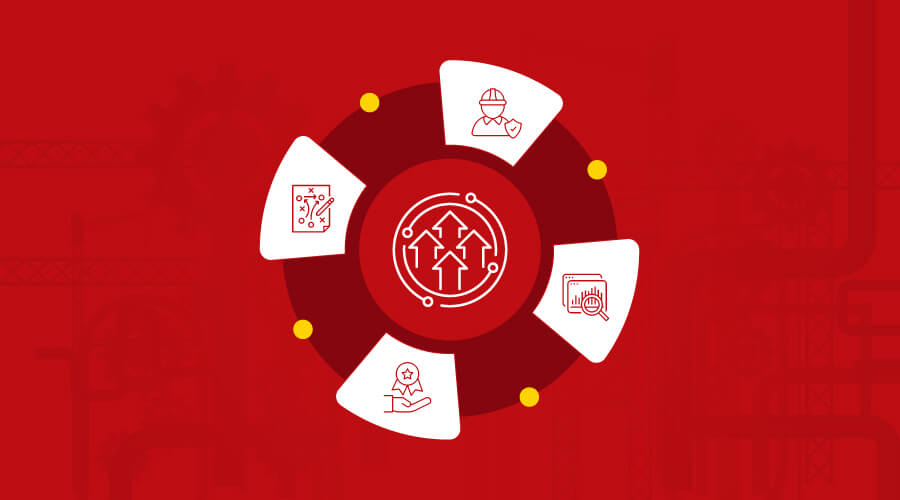
Kaizen- Overview, Implementation and its Benefits
29th Apr, 2021
We live in a microcosm that is constantly evolving. With close-knit communication across the globe, our global market is getting stronger day by day. The competition among the businesses are rising continuously to stand out in the market by providing the best quality products and services at competitive prices. Hence, the companies must seek the best method to increase the speed, quality of their product and reduce the amount of waste.
Many companies are adopting the Lean methodology. Kaizen is one of the crucial pillars of Lean Methodology. It has a different set of definitions but the overall idea is to simply improve. Let us further dive into the details of Kaizen.
.
What is Kaizen?
The term Kaizen is derived from two Japanese words ‘Kai’ denoting ‘change’ and ‘Zen’ denoting ‘good’. Back in the 1980s, this Japanese Philosophy was first introduced by Toyota and since then it is adopted by many companies across the boundaries of the globe.
Kaizen is a statistical strategy that improves quality in every aspect of the business. It is a strategy where employees at all levels work ardently to achieve quality, efficiency, profitability, and create an empowered environment at their workplace. With the implementation of this strategy, workers are engaged in looking for opportunities for change and improvement. This is not a one-time event but a process that occurs every day.
.
How did Kaizen come into existence?
Kaizen began as a part of the “Toyota Production System”, a famous Japanese car manufacturing company. In the 1980s Toyota developed a business process to catch issues in the production at the very moment they occurred. If something did not align with the process, the entire production line would shut down to let the staff identify the solution to the problem.
The motive behind implementing the method was to never let the same problem occur again.
Over time it was observed that there was a visible improvement in the Toyota production system which empowered it to be known as the most efficient and reliable production company.
Since then Kaizen has been one of the respected instruments in Japan as well as an important pillar for them in becoming one the strongest industrialized countries in the world.
.
Why Implement Kaizen?
The Kaizen methodology is beneficial for diverse business models and operational philosophies.
At present, most businesses have the constant urge to upscale the quality and profit margin and reduce waste. If implemented properly, Kaizen methodology can be helpful beyond the scope of reducing waste and increasing quality. It can introduce positive results at overall business results. Let’s look at some crucial out of the many advantages of implementing Kaizen.
- Improvement & Utilization of Resources
The Japanese method focuses on enhancing the products through utilizing the present resources that encompass the people, to achieve constant incremental improvement. Kaizen is based on leveraging upon small changes rather than depending on monument changes or expensive equipment investments to gain improvement.
- Increased Workplace Efficiency
Efficiency is an imperative part of almost every business. Kaizen enables businesses to realize the importance of improving productivity by providing a systematic workplace, avoiding unnecessary movements and operations, and appropriately training all the employees.
- Avoids Information Gap
Quite a few working places experience a communication gap. Information is not communicated properly between different departments or across different managerial positions leading to confusion in the work process. Kaizen encourages open communication channels by promoting productive interactions among all the levels of the teams. Sharing ideas, collaborating thus becomes a normal part of the daily work routine.
- Employee Satisfaction
Kaizen focused on Improving the company culture that increases employee engagement and encourages them to put more quality into their work. The team members are always kept in the loop and asked to examine the process and give inputs for improvement.
- Safety Improvements
Creating a safe work environment is another important criteria of Kaizen. Safety improvement idea is developed and implemented to make the workplace surrounding safe, clean and organized.
.
How to Implement Kaizen?
- DEFINE/PLAN
- Reviewing of existing processes of the company to understand “AS-IS” level
- Conducting various “Kaizen Events
- Goal setting (Top management)
- Capacity Building (Middle management)
- Factory floor level”
- Providing various training on a need basis to support the implementation of Kaizen. Such training includes 7QC Tools, Root cause analysis, etc.
- Kaizen Coach – development and training
- ANALYSIS
- Kaizen theme selection and generation of various kaizen (Kaizen tree)
- Selection of Kaizen
- KAIZEN IMPLEMENTATION
- Build Kaizen Board / Display
- Daily Management Meetings / etc.
- “Kaizen Story
- Plan the Kaizen implementation schedule
- Analyze present situation
- Establish the target
- Root Cause analysis and identification of corrective actions
- Evaluate the results
- Standardize and follow-up”
- SUSTAIN
- Kaizen Training
- Kaizen Audits
- Kaizen Standardization
.
Importance & Benefits of Kaizen
- Waste Reduction
To improve and optimize the process, removing the waste is an important step. The wastage can include resources or manpower.
- Productivity
Reducing waste is directly proportional to productivity. As the waste is reduced, productivity increases.
- Results Orientation
Kaizen is a result-oriented process. There is a clear demarcation of where the company is operating and what goal it wants to accomplish.
- Quality
With a strategic plan and improvement in mind, the managers always aim to yield optimum quality. Kaizen focuses on boosting the quality of products and processes at every step.
- Accuracy
As the business focuses on continuously getting high-quality results, processes are found which are accurate and effective.
- Cost Advantage
As every process in the workplace is functioning at high efficiency and productivity, it results in more output at lesser input. There is a huge cost advantage due to such practice.
- Competitive Advantage
Firms that consistently follow Kaizen’s philosophy gain a competitive edge because they diligently work on improving themselves, setting a new benchmark, taking new competitors as their benchmarks, and learning new things along the way.
- Safety
Kaizen recently introduced 6s which stands for safety that ensures the process is safe and the manpower is away from any kind of harm. The 6s includes
- Sort 2. Straighten 3. Sweep 4. Standardize 5. Sustain & 6. Safety
- Empowerment
Despite the different levels of hierarchy involved in Kaizen, everyone has the freedom to share opinions, suggestions, or any expressions, which gives them a sense of empowerment and helps the workplace to flourish.
- Happy Workplace
Following all the above practices result in a positive working environment where every employee knows that they have the power to create a difference in the organization.
- Satisfaction Level
With positive morale, the performance always matches the satisfaction level. It reaches the customers through the product and services they receive, in turn making them satisfied.
- Continuous Improvement
As Kaizen is not a one-time process, there is a continuous scope of improvement, providing many opportunities for the firm to improve.
At 4C, our qualified team comprises experts in providing Kaizen training with a solution to Total Quality Management that’s cost-effective, efficient, and reliable in the long run. Our team has provided training to 45+ clients and 1300+ training hours along with 60+ implementations. To know more about how you can practice Kaizen in your organization, Contact us now.
